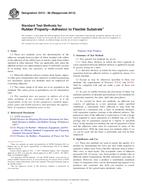We need your consent to use the individual data so that you can see information about your interests, among other things. Click "OK" to give your consent.
ASTM D2240-05(2010)
Standard Test Method for Rubber Property-Durometer Hardness
STANDARD published on 1.1.2010
The information about the standard:
Designation standards: ASTM D2240-05(2010)
Note: WITHDRAWN
Publication date standards: 1.1.2010
SKU: NS-19730
The number of pages: 13
Approximate weight : 39 g (0.09 lbs)
Country: American technical standard
Category: Technical standards ASTM
The category - similar standards:
Annotation of standard text ASTM D2240-05(2010) :
Keywords:
durometer, durometer hardness, hardness, indentation hardness, micro durometer hardness, Durometer hardness, Hardness (indentation)--plastics, Hardness (indentation)--rubber, Penetration--rubber materials/applications, Rubber property analysis, ICS Number Code 83.060 (Rubber)
Additional information
| Significance and Use | ||||||||||||||||
|
This test method is based on the penetration of a specific type of indentor when forced into the material under specified conditions. The indentation hardness is inversely related to the penetration and is dependent on the elastic modulus and viscoelastic behavior of the material. The geometry of the indentor and the applied force influence the measurements such that no simple relationship exists between the measurements obtained with one type of durometer and those obtained with another type of durometer or other instruments used for measuring hardness. This test method is an empirical test intended primarily for control purposes. No simple relationship exists between indentation hardness determined by this test method and any fundamental property of the material tested. For specification purposes, it is recommended that Test Method D785 be used for materials other than those described in 1.1. |
||||||||||||||||
| 1. Scope | ||||||||||||||||
|
1.1 This test method covers twelve types of rubber hardness measurement devices known as durometers: Types A, B, C, D, DO, E, M, O, OO, OOO, OOO-S, and R. The procedure for determining indentation hardness of substances classified as thermoplastic elastomers, vulcanized (thermoset) rubber, elastomeric materials, cellular materials, gel-like materials, and some plastics is also described. 1.2 This test method is not equivalent to other indentation hardness methods and instrument types, specifically those described in Test Method D1415. 1.3 This test method is not applicable to the testing of coated fabrics. 1.4 All materials, instruments, or equipment used for the determination of mass, force, or dimension shall have traceability to the National Institute for Standards and Technology, or other internationally recognized organizations parallel in nature. 1.5 The values stated in SI units are to be regarded as standard. The values given in parentheses are for information only. Many of the stated dimensions in SI are direct conversions from the U. S. Customary System to accommodate the instrumentation, practices, and procedures that existed prior to the Metric Conversion Act of 1975. 1.6 This standard does not purport to address all of the safety concerns, if any, associated with its use. It is the responsibility of the user of this standard to establish appropriate safety and health practices and determine the applicability of regulatory limitations prior to use. |
||||||||||||||||
| 2. Referenced Documents | ||||||||||||||||
|
Similar standards:
Historical
1.5.2012
Historical
1.1.2013
Historical
1.11.2013
Historical
1.5.2014
Historical
1.5.2012
Historical
1.5.2011
We recommend:
Technical standards updating
Do you want to make sure you use only the valid technical standards?
We can offer you a solution which will provide you a monthly overview concerning the updating of standards which you use.
Would you like to know more? Look at this page.



 ASTM D4026-06(2012)..
ASTM D4026-06(2012).. ASTM D412-06a(2013)..
ASTM D412-06a(2013).. ASTM D413-98(2013)..
ASTM D413-98(2013).. ASTM D429-14
ASTM D429-14 ASTM D430-06(2012)..
ASTM D430-06(2012).. ASTM D4482-11
ASTM D4482-11
 Cookies
Cookies
